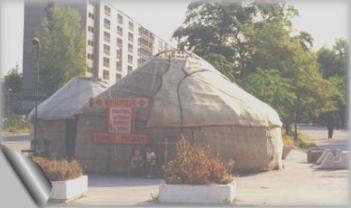 Kyrgyzstan's bustling, young capital lies 800m above sea level in the country's northwest. Only 25km from the Kazak border, Bishkek is
fringed to the south by the spectacular Kyrgyzsky Ala-Too mountain range, visible from every part of the city. Bishkek's wide boulevards are lined with oak, elm and sycamore trees, prompting the travel writer, Colin Thuberon, to comment that the city seems to have been built in a
forest. Kyrgyzstan's bustling, young capital lies 800m above sea level in the country's northwest. Only 25km from the Kazak border, Bishkek is
fringed to the south by the spectacular Kyrgyzsky Ala-Too mountain range, visible from every part of the city. Bishkek's wide boulevards are lined with oak, elm and sycamore trees, prompting the travel writer, Colin Thuberon, to comment that the city seems to have been built in a
forest.
The city offers its visitors a host of exciting possibilities:
colourful Central Asian bazaars, thought-provoking museums,
art galleries showcasing Kyrgyz talent, vast green parks,
quirky curiosities and an array of day trips outside Bishkek itself. As one of the world's smallest capitals (pop 800,000) the city centre is compact and easily explored on
foot. Bishkek's modern restaurants serve traditional Kyrgyz and foreign cuisine at reasonable prices, whilst its international-standard hotels cater for the expectations of western visitors. Bishkek's citizens are a lively mixture of over 22 ethnic groups, including Tatars, Armenians, Uzbeks, Dungan Chinese and Koreans. However,
Kyrgyz and Russian remain by far the most dominant cultural influences. It is not unusual to see a yurt standing incongruously on the pavement, men wearing the traditional Kyrgyz ak-kalpak white felt hat, or livestock being driven to market down suburban streets. Decades of Soviet rule mean that most signs and notices are in Russian and that many Russian cultural practices (such as queuing twice when buying goods) are still in evidence.
Why "Bishkek"? | Getting to Bishkek and Moving On | Bishkek's History | Pictures of Bishkek |

